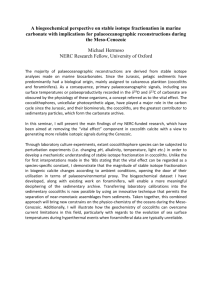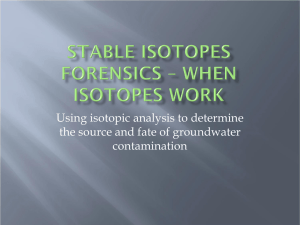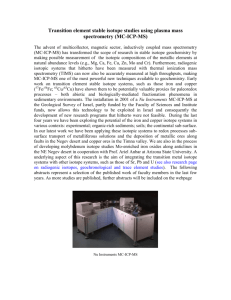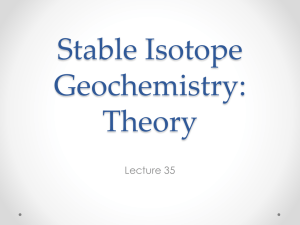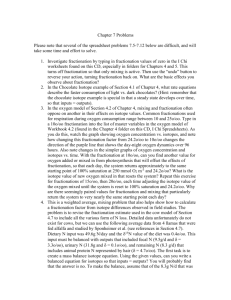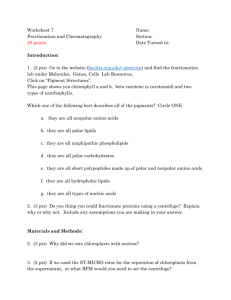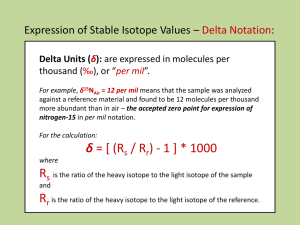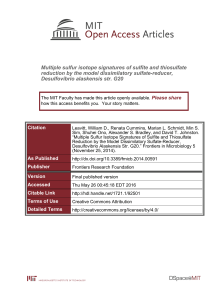GBI_292_sm_DataS1
advertisement
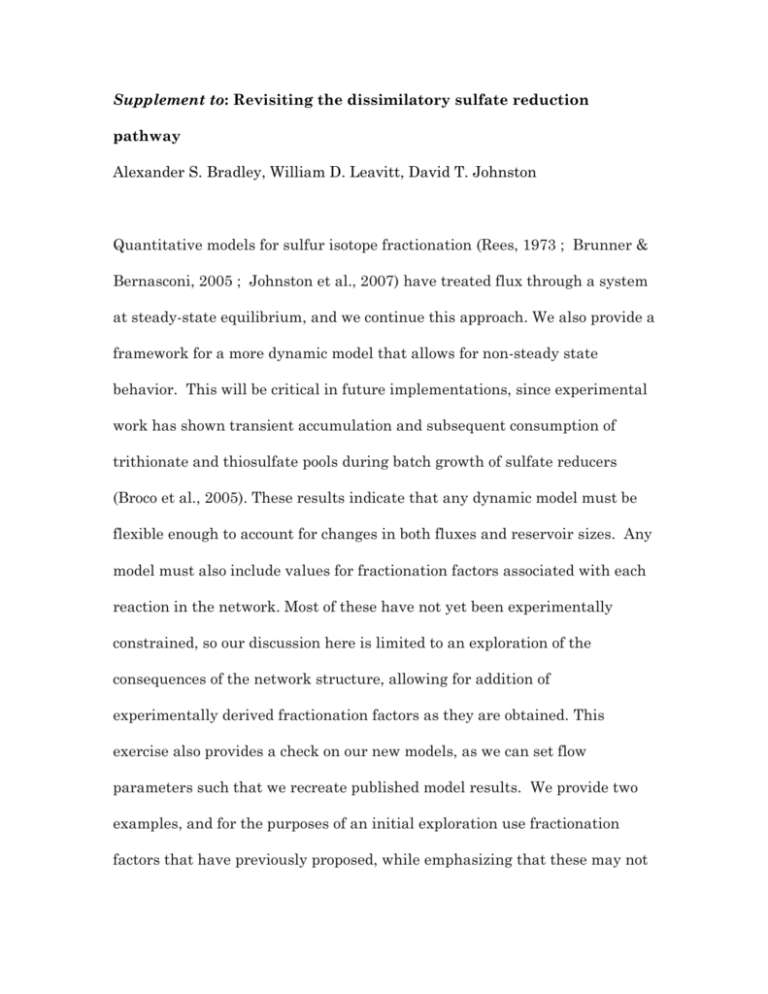
Supplement to: Revisiting the dissimilatory sulfate reduction pathway Alexander S. Bradley, William D. Leavitt, David T. Johnston Quantitative models for sulfur isotope fractionation (Rees, 1973 ; Brunner & Bernasconi, 2005 ; Johnston et al., 2007) have treated flux through a system at steady-state equilibrium, and we continue this approach. We also provide a framework for a more dynamic model that allows for non-steady state behavior. This will be critical in future implementations, since experimental work has shown transient accumulation and subsequent consumption of trithionate and thiosulfate pools during batch growth of sulfate reducers (Broco et al., 2005). These results indicate that any dynamic model must be flexible enough to account for changes in both fluxes and reservoir sizes. Any model must also include values for fractionation factors associated with each reaction in the network. Most of these have not yet been experimentally constrained, so our discussion here is limited to an exploration of the consequences of the network structure, allowing for addition of experimentally derived fractionation factors as they are obtained. This exercise also provides a check on our new models, as we can set flow parameters such that we recreate published model results. We provide two examples, and for the purposes of an initial exploration use fractionation factors that have previously proposed, while emphasizing that these may not be experimentally verified. To implement the network as a model, we write a differential equation for the isotopic composition of each intermediate under non-steady-state conditions (see below). In the non-steady-state approach, solutions require quantification of intracellular metabolite concentrations, as well as an understanding of the dependence of mass fluxes on metabolite concentrations as dictated by enzyme kinetics. Detailed investigations are required to constrain these variables, so for the present we simplify the solutions and exclude the transient terms to solve for the steady-state equations. The network and terms included in our model are shown in Figure S1. Each intermediate has an isotope ratio R, equivalent to the ratio of 3xS/32S (3x = 33, 34, or 36). Each reaction in the network has an associated flux term j. This term may be in any units, but for simplicity we define j0 = 1 and model other fluxes as a fractional proportion of this flux (ensuring mass balance). Each reaction in this network also has an associated fractionation αλ, where 34λ = 1, 33λ = 0.515 and 36λ = 1.90 (Farquhar et al., 2003). For each simulation a set of fractionation factors are chosen, as is the reversibility, the relative importance of each side reaction, and the proportion of each intermediate that leaks out of the cell (Table S1). Several other rules can be applied to constrain our model. For example, the stoichiometry of each reaction places constraints on several of the fluxes, e.g. the flux of sulfite to trithionate (j7) must be twice that of the reduced intermediate S2+ (j6). We apply these rules to solve for each flux term for any given set of parameters. The steady-state solution for the isotope ratio R of any given intermediate is given as ss n R ( R ) j ( R ) i i o i (1) o where ( i Ri ) j i is the sum of all contributions into the the pool of intermediate n. i.e. this term represents the summed contribution of all reactions that form intermediate n, while accounting for their isotopic compositions and the associated fractionation. For example, the isotopic composition of intracellular sulfate is the product of both imported extracellular sulfate, modified by its associated fractionation factor (RSO4out, j0 and α0), and the back reaction from APS (RAPS, j1r and α1r). The flux and composition of material moving out of a given reservoir are treated similarly, and appear in the denominator of Equation 1. The full suite of equations for both the steady state and non-steady state solutions are given below. Our model suggests that the challenge to understanding sulfur isotope fractionation lies in understanding the magnitude of the fractionation factors at each step, and the conditions that change the flux through various parts of the network. We define each fractionation factor α as Rreactant Rproduct or alternatively, R product * Rreactant For simplicity in the following equations, we have omitted superscripts indicating the isotope to which we are referring. The equations are identical for each isotope, except for variation in the value of λ and R. In these equations, each Rn can be interpreted as 3xRn, and each α can be interpreted as 3x For the intermediate thiosulfate, the model distinguishes between the two sulfur atoms. The sulfanyl sulfur is denoted as ‘S2O3-S1’, while the sulfonyl is denoted as ‘S2O3-S2’. Similarly for trithionate, the sulfanyl sulfur is denoted ‘S3O6-S1’, while each of the two sulfonyl sulfurs are assumed to be identical, and denoted as ‘S3O6-S2’. Solution to the model for any given set of parameters requires two steps. In the first step, we find the solution to the set of fluxes for the given parameters. In the second step, we apply these fluxes and the given fractionation factors to solve for the isotopic composition of each intermediate. Table S1 lists the model parameters, and Table S2 shows how they are varied in the two examples given here. Fluxes Fluxes are solved by the following set of equations, which incorporate both the steady-state requirement that the concentration of each intracellular metabolite remain unchanged, and reaction requirements given by the stoichiometry of each reaction: j0 1 j0r rev0 j1 j 0 j 0r 1 rev1 j1r j1 * rev1 j 2 j 0 j 0r 1 rev2 j2r j2 * rev2 j3 j2 j12 j14 j2r j11 j7 j9 j15 j4 j 3 j6 j5 j 4 j8 j6 j3 * dsrs1 j7 2* j6 j8 j4 * dsrs2 j9 j 8 j10 j6 j16 j11 j10 *(1 TR1) j12 j10 j10 *(1 TR1) j13 j10 j8 j17 j14 j13 j15 j 2 j 2r * leakSO3 j16 j6 * leakS3O6 j17 j 8 j10 * leakS2O3 j18 j5 j13 The solutions for the fluxes j0, j0r, j1, j1r, j2, j2r are functions of the parameters rev0, rev1, and rev2. To simplify the mathematical treatment, we currently allow reversibility only on the reactions between sulfate and sulfite, as outlined in the Rees model, and do not consider abiotic reactions. Therefore this model may not yet appropriately treat back reactions from sulfide. A full treatment will incorporate this when more information is available regarding appropriate fractionation factors. Under the given conditions, the fluxes j4 – j18 can each be rewritten in terms of the input parameters and the flux j3, and are easily solved once the solution to j3 is obtained. The solution to j3 is more complicated to find – it depends on the parameters, but in the equations given above relies on the solutions to j4 – j18, which are in turn dependent on j3. In other words, the equation for the flux j3 is recursive. We therefore write the equation for flux j3 as a non-homogenous recurrence relation, of the form j3 (n 1) r * j3 (n) k . In this expression, the solution j3 at recursion depth (n+1) is a function of the solution at depth n and the parameters r and k. The parameters r and k are functions only of the input parameters, which include the reversibility of the steps between sulfate and sulfite, the flux to each side reaction, and the leakage of each intermediate. The closed-form solution to the recurrence relation depends only on the input parameters and n. Models runs indicate that a stable solution for j3 is typically found at a recursion depth of less than 100. Therefore, for a given set of parameters, we then find the solution for j3 for an arbitrarily large n >> 100 (typically 10,000). Remaining fluxes j4 – j17 are then solved in terms of j3. Isotope ratios- steady state solutions For the nth metabolic intermediate, we can write the equation for the change with time in the ratio 3xR (excluding the ‘3x’ superscript for simplicity): Rn R j R j i o i i i o o Mn where, as explained in the main text, into a pool, and (1) o R j o o o o R j i i i i is the sum of contributions is the sum of all fluxes out of a pool. Mn is the reservoir size of metabolic intermediate n. Equation 1 can be solved for the value of each Rn as a function of time: iRi ji j / M t Rn (t) Rn (0) e o o n oRo (2) This transient term in this equation is dependent on the intracellular concentration (Mn) of intermediate n. If we take the limit of this equation as t approaches infinity, the transient term approaches zero and we have the steady state solution to the isotope ratio Rn: Rnss R j R i i o i o These equations can be solved for each intermediate. Based on the network shown in Figure S1, the steady state solutions are given as follows: ss RSO4 ( 0 RSO4 out ) j 0 (1r RAPS ) j1r 1 j1 0r j 0r ss RAPS (1RSO4 ) j1 ( 2r RSO3 ) j 2r 2 j 2 1r j1r ss RSO3 ( 2 RAPS ) j 2 (12RS 3O 62 ) j12 (14 RS 2O 32 ) j14 2r j 2r 3 j 3 7 j 7 9 j 9 11 j11 15 j15 RSss3O 6S1 ( 6 RS 2 ) j 6 10 j10 j16 RSss3O 6S 2 ( 7 RSO3 ) j 7 12 j12 2 j16 RSss2O 3S1 ( 8 RS ) j 8 (10RS 3O 6S1 ) j10 13 j13 j17 RSss2O 3S 2 ( 9 RSO3 ) j 9 (TR1* RS 3O 6S 2 ) j10 (11RSO3 ) j11 14 j14 j17 RSss ( 4 RS 2 ) j 4 5 j 5 8 j8 RSss2 ( 3 RSO3 ) j 3 4 j 4 6 j6 R Hss 2S ( 5 R5 ) j 5 (13RS 2O 3S1 ) j13 18 j18 These steady-state equations form a discrete dynamical system of recurrence relations, each of which is similar in form to the equation for flux j3. The system of equations can be written in matrix form such that r r x(n 1) Ax (n) r where A is the matrix of coefficients of the steady state solutions, x is the vector containing the isotope ratio of each metabolic intermediate, and n is r the recursion depth. We define x (0) as a vector consisting of the isotope ratios where each R = CDT, i.e. each δ3xS=0‰. We wish to find a stable solution r r r r x (n) where x(n) Ax (n) . The solution for x (n) is difficult to find explicitly, since in this application A is a singular matrix, with fewer eigenvalues than the matrix dimension. Therefore, we find the stable solution by computationally raising A to an arbitrarily large power n (typically 106) such r r that x(n 1) A n x(n) . The matrix A n reduces all isotope effects and fluxes to a r single term for each intermediate that multiplied by x (0) yields the steady state isotope model. Example 1: A Rees-like model In this example, we maintain the full network structure, but simplify the fluxes so that sulfite only reacts with DsrAB or back-reacts toward sulfate (Figure S1). Reactions between sulfate and sulfite are reversible, while the reduction of sulfite to sulfide (by DsrAB and DsrC) is irreversible. For comparison to previous models, we examine two sets of parameters. In the first set, we assign α0 = 1.003, and α2 = α3 = 0.975 (i.e. Rees). In the second set, we assign α0 = 1.003, α2 = 0.975, and α3 = 0.947 (i.e. BB05). All other α values are 1.000. It is important to realize that in this approach the full fractionation between sulfite and sulfide is assigned to α3 (which corresponds, approximately, to the formation of a Fe-S bond between sulfite and siroheme). This may not reflect the actual location of fractionation in vivo but is maintained here as an example. With the fractionation factors from the Rees model, sulfide varies from δ34SSO4-H2S = +3‰ for the case of an irreversible reaction, to δ34SSO4-H2S = -47‰ for a reaction that is 99% reversible (Figure S2a). These results replicate Rees, but extend the calculations over the full range of reversibility, and additionally calculate the δ34S values of intracellular intermediates, as in Johnston et al. (2007). With this network structure, the network parameters rev0 and rev2 are varied between 0 and 0.99 (rev = 1 would imply zero forward reaction and mathematically be undefined), and represent the proportion of sulfate import into the cell that can flux back out (rev0), and the proportion of sulfite that regenerates APS (rev2). We assume that rev1, representing the back reaction of APS to sulfate is fully reversible (rev1 = 0.99). In the absence of this assumption, the solution field collapses so that the only expressed fractionation is α0. As expected, if the input values are changed to mimic BB05, 99% reversibility for both rev0 and rev2 produces δ34S SO4-H2S = -72‰, in accordance with the BB05 results, and a slightly higher Δ33SH2S than Rees, with values up to +0.205 (Figure S2b). The features illustrated with this network structure are fully consistent with previously published work (Brunner and Bernasconi, 2005; Johnston et al., 2005; 2007). Example 2: Sulfate reduction with thionate loop Important features of the potential thionate loop have not been fully addressed in previous models, and are only partially addressed here. For instance, while the BB05 model included thionates, it did not recognize intramolecular distinctions between sulfur atoms in trithionate or thiosulfate, nor did it not incorporate branching (the BB05 network was linear). For example, we recognize the importance of intramolecular differences between the oxidized and reduced moities of thionates. But in the absence of information regarding the kinetic or equilibrium isotope effects in the production and consumption of these molecules, it is difficult quantify the effect this side pathway will have on the isotopic composition of sulfide. If the reactions involved in creating and then reducing thionates are irreversible, then the effect of this pathway on the isotopic content of sulfide will be minimal. However, if these species are in isotopic equilibrium there could be a significant contribution. Figure S3 shows the results of a model in which the Rees fractionations are applied to the central pathway, while including the thionate loop and applying α13 = 0.995 and α14 = 0.985 (Smock et al., 1998) to these reactions. While the fractionation factors may differ from the estimate presented here, this principally demonstrates the prediction that oxidized moities of thiosulfate should be enriched in 34S relative to the reduced moities. The effect on sulfide will vary as a result of allowing exchange reactions with the extracellular environment. Figure S4 shows the results of the same model with varying amounts of produced thionates (up to 30%) allowed to leak from the cell to the extracellular environment. Our purpose here is again not to offer a quantitative prediction, but to demonstrate that these parameters can impact the isotopic composition of products, and are currently unquantified in most experimental approaches to understanding sulfur isotope fractionation. Figures & Tables Figure S1: Network of reactions in the isotope model. Similar to Figure 1 in the main text, but including the model parameter associated with each reaction. Figure S2: a) Model results for the Rees-like pathway showing the isotopic compositions of intracellular sulfide, sulfite, and sulfate with Rees fractionation factor applied to α3. b) same result with BB05 fractionation factor applied to α3. Figure S3: Isotopic composition of intracellular sulfide (thin black dotted field), sulfite (thin grey dotted field), and the sulfanyl (thick black field), and sulfonyl (thick grey field) of trithionate in a reaction network with a thionate loop and no leaks. Thiosulfate reductase is assumed to have the fractionation factors given by Smock et al. (1998). Figure S4: Isotopic composition of sulfide produced by a cell with a thionate loop and various proportions of thionate leaks. Table S1: Parameters in the branching network model Table S2: Assigned values for parameters in the examples given in the text References Broco M, Rousset M, Oliveira S, Rodrigues-Pousada C (2005) Deletion of flavoredoxin gene in Desulfovibrio gigas reveals its participation in thiosulfate reduction. Febs Lett, 579, 4803-4807. Brunner B, Bernasconi S (2005) A revised isotope fractionation model for dissimilatory sulfate reduction in sulfate reducing bacteria. Geochim Cosmochim Ac, 69, 47594771. Farquhar J, Johnston DT, Wing BA, Habicht KS, Canfield DE, Airieau S, Thiemens MH (2003) Multiple sulphur isotopic interpretations of biosynthetic pathways: implications for biological signatures in the sulphur isotope record. Geobiology, 1, 27-36. Johnston D, Farquhar J, Canfield D (2007) Sulfur isotope insights into microbial sulfate reduction: When microbes meet models. Geochimica et Cosmochimica Acta, 71, 3929-3947. Rees C (1973) A steady-state model for sulphur isotope fractionation in bacterial reduction processes. Geochim Cosmochim Ac, 37, 1141-1162. Smock A, Böttcher M, Cypionka H (1998) Fractionation of sulfur isotopes during thiosulfate reduction by Desulfovibrio desulfuricans. Archives of Microbiology, 169, 460-463.
